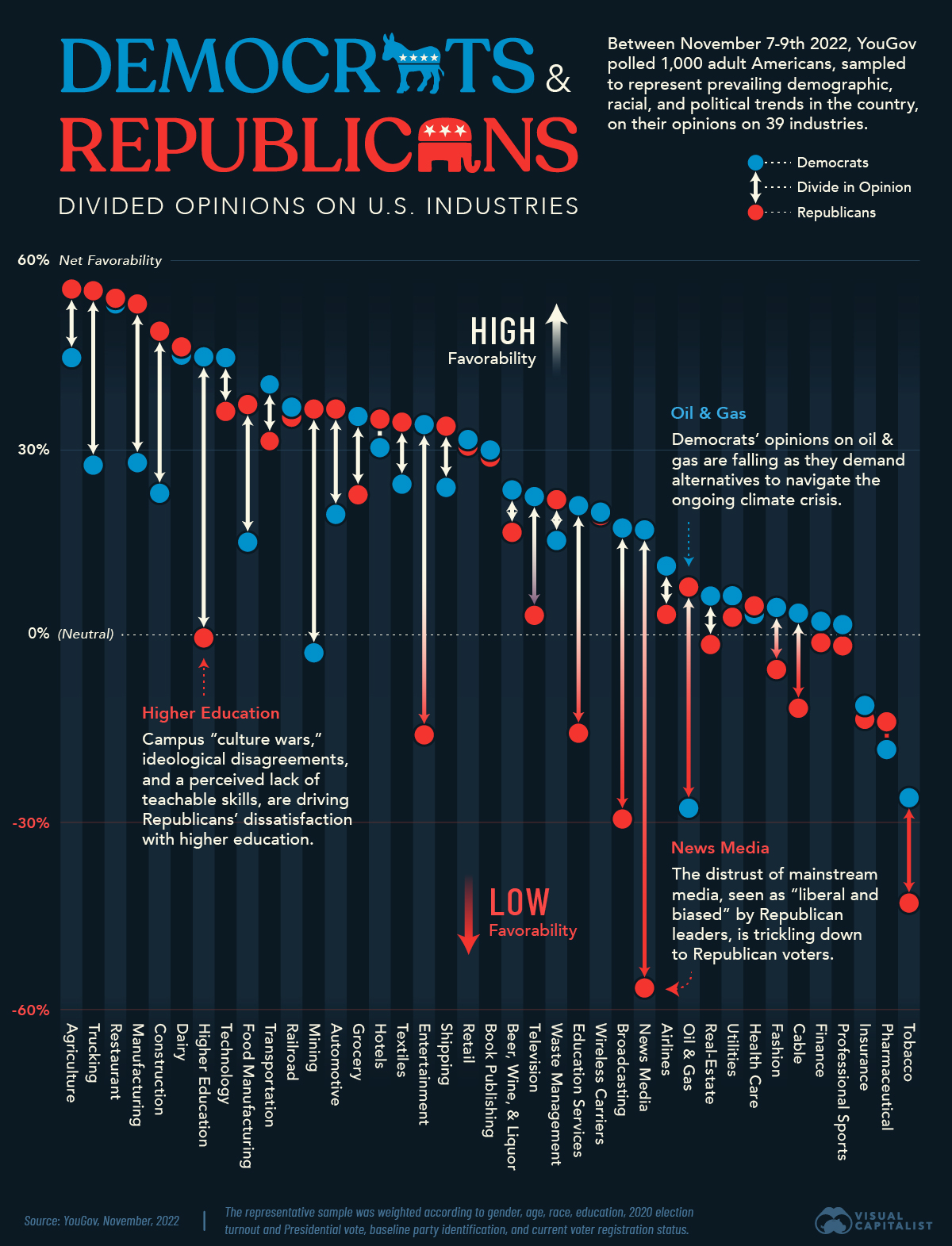![]()
See this visualization first on the Voronoi app.

Industry Favorability, by Political Party
This was originally posted on our Voronoi app. Download the app for free on iOS or Android and discover incredible data-driven charts from a variety of trusted sources.
Much and more has been written, in the last decade particularly, about the U.S. political sphere becoming increasingly polarized. The two main parties—Democrats and Republicans—have clashed over how to run the economy, as well as on key social issues.
Perhaps unsurprisingly then, Democrat and Republican voters are also divided on various U.S. industries, per a YouGov poll conducted in 2022.
Between November 7-9th of that year, the market research firm polled 1,000 adult Americans, (sampled to represent prevailing demographic, racial, and political-party-affiliation trends in the country) on their opinions on 39 industries. They asked:
“Generally speaking, do you have a favorable or unfavorable opinion of the following industry?” — YouGov Poll.
In this chart we visualize the percentage with a favorable view of an industry minus those with unfavorable view, categorized by current voter status.
A higher percentage means more Democrats or Republicans rated the industry as favorable, and vice-versa. Negative percentages mean more respondents responded unfavorably.
Democrats vs. Republicans on Industry Favorability
From a glance, it’s immediately noticeable that quite a few industries have divided Democrats and Republics quite severely.
For example, of the sampled Democrats, a net 45%, found Higher Education “favorable.” This is compared to 0% on the Republican side, which means an equal number found the industry favorable and unfavorable.
Here’s the full list of net favorable responses from Democrats and Republicans per industry.
| Industry | Democrat Net Favorability |
Republican Net Favorability |
|---|---|---|
| Agriculture | 44% | 55% |
| Trucking | 27% | 55% |
| Restaurant | 53% | 54% |
| Manufacturing | 27% | 53% |
| Construction | 23% | 49% |
| Dairy | 45% | 46% |
| Higher education | 45% | 0% |
| Technology | 44% | 36% |
| Food manufacturing | 15% | 37% |
| Transportation | 27% | 37% |
| Railroad | 37% | 35% |
| Mining | -3% | 36% |
| Automotive | 19% | 36% |
| Grocery | 35% | 22% |
| Hotels | 30% | 35% |
| Textiles | 24% | 34% |
| Entertainment | 34% | -17% |
| Shipping | 24% | 33% |
| Retail | 31% | 31% |
| Book publishing | 30% | 29% |
| Alcohol | 23% | 16% |
| Television | 22% | 3% |
| Waste management | 15% | 22% |
| Education services | 21% | -16% |
| Wireless carriers | 19% | 19% |
| Broadcasting | 17% | -30% |
| News media | 17% | -57% |
| Airlines | 11% | 3% |
| Oil and gas | -28% | 7% |
| Real-estate | -2% | 6% |
| Utilities | 2% | 6% |
| Health care | 3% | 4% |
| Fashion | 4% | -6% |
| Cable | -12% | 3% |
| Finance | 2% | -2% |
| Professional sports | 1% | -2% |
| Insurance | -12% | -14% |
| Pharmaceutical | -18% | -14% |
| Tobacco | -44% | -27% |
The other few immediately noticeable disparities in favorability include:
- Mining and Oil and Gas, (more Republicans in favor),
- Entertainment, Education Services, and News Media (more Democrats in favor).
Tellingly, the larger social and political concerns at play are influencing Democrat and Republican opinions about these parts of the economy.
For example Pew Research pointed out Republicans are dissatisfied with universities for a number of reasons: worries about constraints on free speech, campus “culture wars,” and professors bringing their politics into the classroom.
In contrast, Democrats’ criticisms of higher education revolved around tuition costs and the quality of education offered.
On a more recent note, Citadel CEO Ken Griffin, a big Harvard donor, pulled funding after criticizing universities for educating “whiny snowflakes.” In October, donors to the University of Pennsylvania withdrew their support, upset with the university’s response to the October 7th attacks and subsequent war in Gaza.
Meanwhile, the reasons for differences over media favorability are more obvious. Commentators say being “anti-media” is now part of the larger Republican leadership identity, and in turn, is trickling down to their voters. Pew Research also found that Republicans are less likely to trust the news if it comes from a “mainstream” source.
But these are industries that are already adjacent to the larger political sphere. What about the others?
U.S. Politics and the Climate Crisis
The disparity over how the Oil & Gas and Mining industries are viewed is a reflection, again, of American politics and the partisan divide around the climate crisis and whether there’s a noticeable impact from human activity.
Both industries contribute heavily to carbon emissions, and Democrat lawmakers have previously urged the Biden transition to start planning for the end of fossil-fuel reliance.
Meanwhile, former President Trump, for example, has previously called global warming “a hoax” but later reversed course, clarifying that he didn’t know if it was “man-made.”
When removing the climate context, and related environmental degradation, both industries usually pay high wages and produce materials critical to many other parts of the economy, including the strategic metals needed for the energy transition.
The post How Do Democrats and Republicans Feel About Certain U.S. Industries? appeared first on Visual Capitalist.